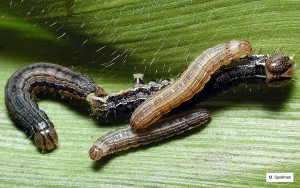It’s been many years since we’ve seen a true armyworm (see the attached image) infestation in our small grain crop, but one is reported to be ongoing in the barley and wheat fields on the Eastern Shore. These caterpillars can do two types of damage—leaf feeding and head cutting. Leaf feeding is rarely extensive enough to warrant control, especially if fields are within a couple of weeks of harvest. Head cutting is less tolerable. For some reason no one has been able to explain, caterpillars will sometimes eat through the stem below the heads casing them to drop to the ground. Finding otherwise healthy looking heads-short stems on the ground is a good indicator that true armyworms are present and still active. It is often hard to find them on plants during the day as they typically feed more at night and seek cover under plant residue during the day. When we have worked with this pest, we found that fields with the most plant residue on the soil surface tended to have the heaviest infestations.
We do have thresholds for true armyworm for those motivated to scout for them. As a general rule, barley should be treated if the number of armyworms exceeds one per linear foot between rows and most of the worms are greater than 0.75-inch long. In wheat, armyworms tend to nibble on the tips of kernels rather than clip heads; thus, populations of two to three worms per linear foot between rows are required to justify control. In high management wheat fields with 4-inch rows, treatment is recommended when armyworm levels exceed 3 to 5 per square foot of surface area, or per linear foot of row.
If a treatment is warranted, there are a few good choices but the PHI (Pre Harvest Interval) may be a challenge. Some work we did many years ago showed that pyrethroids were generally effective but have a PHI of 14 days (example, Mustang Max) to 30 days (example, Baythroid), which could be a problem for barley, wheat not so much. Lannate has a PHI of 7 days but did only an OK job in our trial and not as good as the pyrethroids. We chalked that up to the fact that although Lannate has great efficacy against most caterpillar species, it has almost zero residual activity. So a day-time spray may not have had as much horsepower by the evening when caterpillars become active. Since our work was done, several new products have been introduced to the market that we have not tested, like Prevathon (PHI 14 days), and Besiege (PHI 30 days). These should work well. See the Pest Management Guide Field Crops 2016, 4-49, p. 53 for more product listings (http://www.pubs.ext.vt.edu/456/456-016/Section04-Insects-1.pdf).
With any treatment, coverage will be essential so deliver the highest volume you can live with and direct it to go as deep into the canopy as possible.

